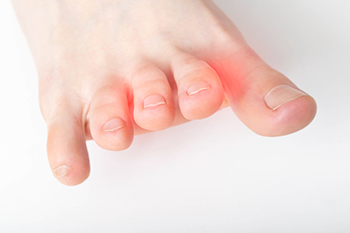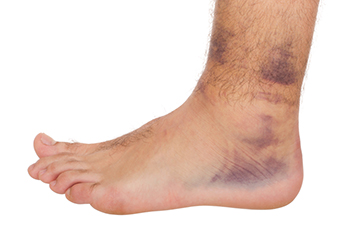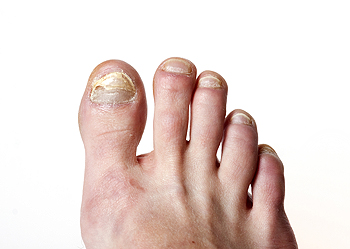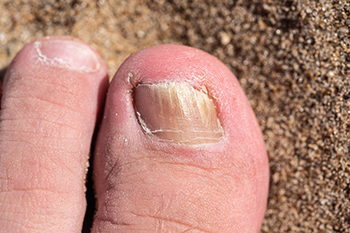Paramus / Wayne: (201) 989-0388
Clifton / Randolph: (973) 834-8853
Edison: (732) 314-7708
Montclair: (973) 834-8987
Items filtered by date: August 2022
Are You Suffering From Ingrown Toenails?
Figure and Ice Skating Foot Injuries

Ice skating requires balance, flexibility, strength, and power. In the 1990s, patterns that generated shapes like circles and figure eights were replaced with more physically demanding jumps and spins. As expected, skating can stress the muscles, bones, and joints of the feet and ankles. Injuries in skating often happen from falls. A skater’s feet are tightly bound in leather or synthetic composite boots so the feet and ankles bear the brunt of various motions performed. Problems can arise from repetitive stretching of the Achilles tendon, located at the heel of the foot, and a skater can get Achilles tendinopathy, tendonitis in the ankle, plantar fasciitis, bunions, calluses, hammertoes, or other foot and ankle problems. Skaters should warm up and stretch before skating to loosen stiff muscles and wear properly fitting boots. If you are a skater and have sports-related pain in your feet or ankles that is not relieved with rest, see a podiatrist for proper diagnosis and treatment.
Sports related foot and ankle injuries require proper treatment before players can go back to their regular routines. For more information, contact one of our podiatrists of Foot & Ankle Institute at One Oak Medical. Our doctors can provide the care you need to keep you pain-free and on your feet.
Sports Related Foot and Ankle Injuries
Foot and ankle injuries are a common occurrence when it comes to athletes of any sport. While many athletes dismiss the initial aches and pains, the truth is that ignoring potential foot and ankle injuries can lead to serious problems. As athletes continue to place pressure and strain the area further, a mild injury can turn into something as serious as a rupture and may lead to a permanent disability. There are many factors that contribute to sports related foot and ankle injuries, which include failure to warm up properly, not providing support or wearing bad footwear. Common injuries and conditions athletes face, including:
- Plantar Fasciitis
- Plantar Fasciosis
- Achilles Tendinitis
- Achilles Tendon Rupture
- Ankle Sprains
Sports related injuries are commonly treated using the RICE method. This includes rest, applying ice to the injured area, compression and elevating the ankle. More serious sprains and injuries may require surgery, which could include arthroscopic and reconstructive surgery. Rehabilitation and therapy may also be required in order to get any recovering athlete to become fully functional again. Any unusual aches and pains an athlete sustains must be evaluated by a licensed, reputable medical professional.
If you have any questions please feel free to contact our offices located in Wayne, Paramus, Clifton, Montclair, Clifton, Edison, and Randolph, NJ . We offer the newest diagnostic and treatment technologies for all your foot and ankle needs.
What is Morton’s Neuroma, and How Can Symptoms Be Relieved?

Morton’s neuroma is a foot condition that affects the nerves generally between the third and fourth toes. It is defined as a thickening of the tissue surrounding the toes, and it can cause severe pain and discomfort. It can be thought of as a lump of scar tissue in the foot. It may gradually develop from frequently wearing high heels, or if there has been a foot injury. The nerve can become irritated, and there may be a tingling sensation, or a loss of feeling. Some patients feel the pain in the ball of their foot, and this often becomes worse as time progresses. Specific imaging tests may be performed to determine a correct diagnosis, and the foot may be manipulated to reproduce the symptoms. Relief can come from changing the shoes that are worn, and it may help to wear custom-made orthotics which may lessen the pressure from the neuroma. Additionally, it is beneficial to temporarily stop any physical activity, and this may help to reduce the discomfort. If you feel you have developed Morton’s neuroma, it is advised that you seek the counsel of a podiatrist who can guide you toward correct treatment options.
Morton’s neuroma is a very uncomfortable condition to live with. If you think you have Morton’s neuroma, contact one of our podiatrists of Foot & Ankle Institute at One Oak Medical. Our doctors will attend to all of your foot care needs and answer any of your related questions.
Morton’s Neuroma
Morton's neuroma is a painful foot condition that commonly affects the areas between the second and third or third and fourth toe, although other areas of the foot are also susceptible. Morton’s neuroma is caused by an inflamed nerve in the foot that is being squeezed and aggravated by surrounding bones.
What Increases the Chances of Having Morton’s Neuroma?
- Ill-fitting high heels or shoes that add pressure to the toe or foot
- Jogging, running or any sport that involves constant impact to the foot
- Flat feet, bunions, and any other foot deformities
Morton’s neuroma is a very treatable condition. Orthotics and shoe inserts can often be used to alleviate the pain on the forefront of the feet. In more severe cases, corticosteroids can also be prescribed. In order to figure out the best treatment for your neuroma, it’s recommended to seek the care of a podiatrist who can diagnose your condition and provide different treatment options.
If you have any questions, please feel free to contact our offices located in Wayne, Paramus, Clifton, Montclair, Clifton, Edison, and Randolph, NJ . We offer the newest diagnostic and treatment technologies for all your foot care needs.
Arthritis Can Cause Pain in the Feet and Ankles
Facts About Sprained Ankles

Most sprained ankles occur when the ankle rolls outward as the foot twists inward. This causes the ligaments on the outside of the ankle to stretch and possibly tear. With a mild sprain, the ankle may be sore and stiff. It may swell slightly, but you should be able to walk with minor pain. As the severity of the sprain increases, your ankle may become bruised and tender, making walking far more painful. With a severe sprain, the ankle joint will feel unstable, and bearing weight is not possible. Ankle sprains can take a while to heal, but this long process is important to avoid re-spraining the ankle or developing chronic ankle problems. If you hear a popping sound at the time of the sprain, please see a podiatrist immediately. You will undergo an exam and be given a treatment schedule that may include pain medication, exercises, or bracing to protect the joint and allow it to heal properly. In some cases surgery may be required.
Although ankle sprains are common, they aren’t always minor injuries. If you need your ankle injury looked at, contact one of our podiatrists from Foot & Ankle Institute at One Oak Medical. Our doctors can provide the care you need to keep you pain-free and on your feet.
How Does an Ankle Sprain Occur?
Ankle sprains are the result of a tear in the ligaments within the ankle. These injuries may happen when you make a rapid shifting movement while your foot is planted. A less common way to sprain your ankle is when your ankle rolls inward while your foot turns outward.
What Are the Symptoms?
- Pain at the sight of the tear
- Bruising/Swelling
- Ankle area is tender to touch
- In severe cases, may hear/feel something tear
- Skin discoloration
Preventing a Sprain
- Wearing appropriate shoes for the occasion
- Stretching before exercises and sports
- Knowing your limits
Treatment of a Sprain
In many cases, the RICE method (Rest, Ice, Compression, and Elevate) is used to treat ankle sprains. However, you should see a podiatrist to see which treatment option would work best with your injury. In severe cases, surgery may be required.
It is important to ask your doctor about rehab options after you receive treatment for your injury. Stretching, strength training, and balance exercises may help the ankle heal while also preventing further injury.
If you have any questions, please feel free to contact our offices located in Wayne, Paramus, Clifton, Montclair, Clifton, Edison, and Randolph, NJ . We offer the newest diagnostic and treatment technologies for all your foot care needs.
Pesky, Persistent Toenail Fungal Infections

Onychomycosis is the medical term for toenail fungus. While different organisms may be responsible for the infection, dermatophytes are the most common culprits by far. Toenail fungus is a bothersome condition that causes the nails to become discolored, thickened, distorted, ragged, crumbly, brittle, and even smelly in certain cases. Older adults are more prone to contracting a toenail infection because as we age, our nails become more brittle. Brittle nails can crack, which can make it easier for the fungal organism to creep inside the nail and infect it. If you detect any of the symptoms mentioned here, it is advised to seek the care of a podiatrist. Toenail infections can be very difficult to treat at home, given that the organism can burrow deep into the multiple layers of the nail or underneath the nail, making it difficult to target and kill effectively and permanently. Also, home treatment may be risky for people with weakened immune symptoms, diabetes, or circulatory issues.
For more information about treatment, contact one of our podiatrists of Foot & Ankle Institute at One Oak Medical. Our doctors can provide the care you need to keep you pain-free and on your feet.
Toenail Fungus Treatment
Toenail fungus is a condition that affects many people and can be especially hard to get rid of. Fortunately, there are several methods to go about treating and avoiding it.
Antifungals & Deterrence
Oral antifungal medicine has been shown to be effective in many cases. It is important to consult with a podiatrist to determine the proper regiment for you, or potentially explore other options.
Applying foot powder on the feet and shoes helps keep the feet free of moisture and sweat.
Sandals or open toed shoes – Wearing these will allow air movement and help keep feet dry. They also expose your feet to light, which fungus cannot tolerate. Socks with moisture wicking material also help as well.
If you have any questions please feel free to contact our offices located in Wayne, Paramus, Clifton, Montclair, Clifton, Edison, and Randolph, NJ . We offer the newest diagnostic tools and technology to treat your foot and ankle needs.
Plantar Warts Can Be Treated!
Is Laser Treatment Right for My Toenail Fungus?

Toenail fungus is a stubborn and often hard to treat infection of the toenails. Laser treatment is a possible remedy that has helped many people to cure toenail fungus. It is a safe treatment, and may have to be repeated several times for serious infections. It is administered through pulses of energy that produce heat, which penetrates to the nail bed. The tissue becomes decomposed, and this destroys the fungus and surrounding nail. This is generally effective in preventing new fungal growth. There is often a high improvement rate after several weeks, and a culture is taken to prove the infection is gone. After the affected foot is cleaned with a sterile solution, the laser is pointed at the nails to be treated. There are some people who experience side effects, including bleeding and mild pain. If you are afflicted with toenail fungus, please consult with a podiatrist who can determine if laser treatment is right for you.
Laser treatment can be an effective way to get rid of toenail fungus. If you have any questions about laser treatment, consult with one of our podiatrists from Foot & Ankle Institute at One Oak Medical. Our doctors will assess your condition and provide you with quality treatment for fungal nails.
What Are Toenail Fungal Infections?
Onychomycosis, or fungal infection of the nail, is a relatively common and non-serious condition. Around 10 percent of U.S. citizens are afflicted with fungal nails. Common forms of fungus that infect the nail include dermatophytes, yeasts, and molds.
Symptoms of Toenail Fungal Infections Include:
- Nail thickening
- Brittleness of the nail
- Discoloration of the nail
Diagnosis for Fungal Nails
Fungal infections are diagnosed by fungal culture and microscopy. This will rule out any other conditions such as nail trauma, psoriasis, lichen planus, and onychogryphosis.
What Is Laser Treatment?
Laser treatment is a non-invasive, safe, quick, and painless procedure that uses the heat from a laser to kill fungus in the nail. Each infected nail is targeted with a laser for several minutes. The treatment is usually utilized several different times over a select period. During this time, a podiatrist will keep an eye on the infection.
If you have any questions, please feel free to contact our offices located in Wayne, Paramus, Clifton, Montclair, Clifton, Edison, and Randolph, NJ . We offer the newest diagnostic and treatment technologies for all your foot care needs.



